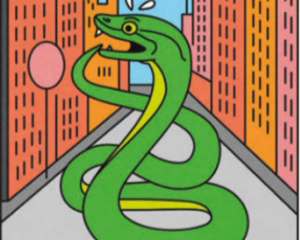"Rock pythons are rarely found in cities," says Santosh Shinde of Spreading Awareness on Reptiles & Rehabilitation Programme (or SARRP, Sanskrit for snake), the outfit that rescued the reptile in the rickshaw. Nonetheless, he says, "Last year we found 25 pythons in one month." As for venomous snakes, it would be easier to list the parts of Mumbai they are not found. SARRP rescued 130 reptiles in June, when the monsoon starts, up 14% from last year.
“城市里很少見到巖蟒,”桑托什·欣德說,他所在的“傳播爬行動物意識和康復項目”(SARRP,梵語中“蛇”的意思)就是在三輪車里救下這條巖蟒的機構。盡管如此,他說,“去年我們一個月里發現了25條蟒蛇。”至于毒蛇,列出孟買沒有毒蛇的地方會更容易。今年6月季風開始時,SARRP救援了130只爬行動物,比去年增加了14%。
"In the summer we get a lot of snakes that are dehydrated and in the monsoon displacement is very common," says Madhurita Gupta of the Snake Conservation Trust, another serpent-saving society. "But this year it has become too much." She attributes the increasing number of snake-sightings to three factors: extreme rainfall driven by climate change, development encroaching on Mumbai's forests and the piles of festering garbage that blight the city.
“夏天我們會碰到很多脫水的蛇,在季風中遷徙的蛇是很常見的。”來自另一個蛇保護組織“蛇保護信托”的馬胡瑞塔·古普塔說。 “但今年的蛇太多了。”她將越來越多的蛇目擊事件歸因于三個因素:氣候變化導致的極端降雨,孟買的森林不斷受到侵蝕,以及摧殘著這個城市的成堆的垃圾。

When people see a snake, they "immediately go to pray or throw (an auspicious) red cloth", says Dr Gupta. Or they "try to kill or attack it, and then they get bitten". Her staff are trying to teach the public to distinguish venomous snakes from others. So is Mr Shinde, who argues that, just as people know the difference between a Doberman and a Pomeranian, they should be able to tell a harmless rat snake from the deadly "big four": cobras, kraits and two types of viper. The WHO reckons 58,000 Indians die every year of snake bites. Official estimates are lower, but still high enough to give India the highest snakebite-mortality rate in the world. On August 13th this year, Hindus mark Naag Panchami, a day on which snakes are worshipped. The best way to honour the creatures may be to learn a little more about them.
古普塔博士說,當人們看到蛇時,他們會“立即祈禱或投擲(吉祥的)紅布”,或者“嘗試殺死或攻擊蛇,然后他們就會被咬”。她的工作人員正試圖教公眾區分毒蛇和其他種類的蛇。欣德也是如此,他認為,就像人們知道杜賓和博美的區別一樣,他們應該能夠區分無害的鼠蛇和致命的“四大”蛇:眼鏡蛇、金環蛇和兩種蝰蛇。據世界衛生組織估計,每年有5.8萬印度人死于蛇咬傷。官方估計的數字較低,但仍足以使印度成為世界上毒蛇咬傷死亡率最高的國家。印度教徒選定8月13日為納嘉潘查密節,他們會在這一天祭拜蛇神。而尊敬這些生物的最好的方式可能就是多了解它們一點。
譯文由可可原創,僅供學習交流使用,未經許可請勿轉載。











